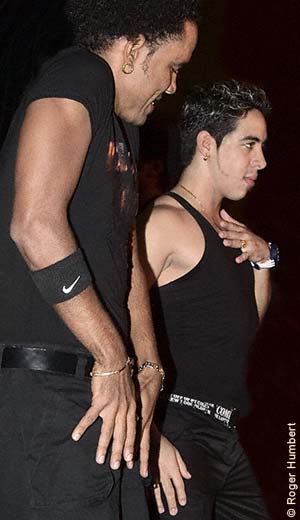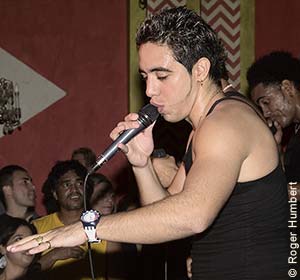 |
David Calzado y su Charanga Habanera
Presented by Lula Lounge, in association with Billy Bryans Productions |
|
| October 28 & 29, 2005 • Lula Lounge • Toronto |
|
|
|
|
|
|
La Charanga Unstrung
by Joyce Corbett with photos by Roger Humbert |
| Lula Lounge is filled to capacity, a-buzz with voices electric. At the door, the standard reply to the disappointed is “maybe tomorrow if you get here early”. The big attraction? La Charanga Habanera, one of the most popular bands in Cuba today, especially with the young. They have played Europe, Latin America, Asia and are now on their first Canadian tour. They will be doing shows in five cities — Quebec City, Montreal, Toronto, Edmonton and Vancouver. |
Often referred to simply as La Charanga, “charanga” is not what they play. Charanga is
a style of Cuban big band music featuring the sounds of flute, violins and cello over a rhythm section of timbales, conga, güiro, double bass
and piano with unison male voices. The original
La Charanga Habanera was put together by violinist David Calzado to play traditional Cuban music of the 40s and 50s at the Club Monte Carlo in Monaco. That was in the late 1980s. The band is still led by David Calzado (who no longer plays violin). Beyond that, only the name remains the same. The personnel and the music have changed. You won’t hear any violins, cellos or flutes in this band. You will hear three trumpets,
a saxophone, keyboards, bass, timbales, congas, percussion, four singers and conductor-singer-rapper David Calzado. |
|

David Calzado |
|
| High-voltage, hard-driving timba is the music this high-energy fourteen piece band puts out and David Calzado is one of the original proponents of this style. Although he has great respect for the music of the past, he decided in Monaco that he didn’t want to go on playing music that was considered old-fashioned in Cuba. He wanted to play the music of contemporary Cuba. The young men in his band grew up in the hard times of Cuba’s “special period”, and the uncertainty of today’s world. They are coming from a different experience and facing a different future. |
|
|
|
The roots of Cuban music are there of course, but the clave moves around, flatted fifths and alt chords pop out in hooks. It’s popular, hard-hitting and musically sophisticated. Soca, calypso, regueton and rap have all been incorporated into an Afro-Cuban-Caribbean-Latino stew, a spicy ajiaco with a dash of Afro-American and jazz snazz. They are the bad boys on the scene, they are controversial. The group has been called the Rolling Stones of Cuba, Calzado the P.Diddy of Havana.
They are tuned in. When they’re in Havana they rehearse Monday to Friday from 2 to 8 p.m. in a poor neighbourhood, “El Fanguito”. There are always people hanging around in the street and listening, a kind of “critical test audience” of real people. If they don’t move to it, Calzado says, we know we don’t have it right. No wonder they are tremendously popular with dancers.
This night in Toronto, a singer and bass player start alone, to the vocalized delight of some female members of the audience. I’m thinking romantic ballad but the rest of the band arrives on stage and the music changes. I’m talking four frontmen singers like multiple Elvis the pelvis, two in black sleeveless T’s, two in black T’s with Macho Latino in silver letters on the front. Cuban Rolling Stones? Mick may be up to it still but I can’t imagine the rest of the boys ever pulling off these moves. They rap, they sing, they shake it on out. David Calzado, back to the audience, directs the musicians from the middle of the stage. The audience moves to the music, some start singing. Gripping the sides of his drums, the conguero hoists himself above them and lands a few hits with his knees.
David Calzado turns to the audience and fires off a round of rapid-fire rap in machine-gun Spanish. But it doesn’t hurt. Complex percussion (instead of an electronic machine beat) and the ever-present sensuality of the music run underneath. This performance is a collaborative effort. On stage and in front. There is a large contingent of Canadian Cubans in the room and when Sarita (leader of a Cuban dance troupe in Toronto), comes up on stage and drapes David Calzado in a Cuban flag it is a special moment.
La Charanga’s show aims to impress and to share. The choreography is an integral part of the whole, as important to the performance as the music. They ask for audience participation and they get it. They invite women up to dance on stage. They encourage people to let loose and enjoy themselves.
|
|
 |
|
La Charanga sing their hits “Somos La Charanga”, “Hay Amor” and of course the infamous “Lola, Lola”, a song filled with double entendres that got them into trouble at an International Youth Festival in Havana in 1997, not for the sexual innuendos, but for a possible reference to smoking marijuana. They had arrived on stage in true Rock Star fashion, descending from a helicopter. They were being broadcast live on Cuban TV. Already displeased with the lyrics of Lola, authorities pulled the plug when singer Michel Maza peeled off his shirt and, back to the audience, appeared to be ready to drop his pants.
With their chops, their street-wise attitude and their well-executed choreography these guys represent the new wave of Cuban music. Thank you, Billy Bryans Productions and Lula for bringing La Charanga Habanera to Toronto.
|
|
|
|
|
|
|
|
|








